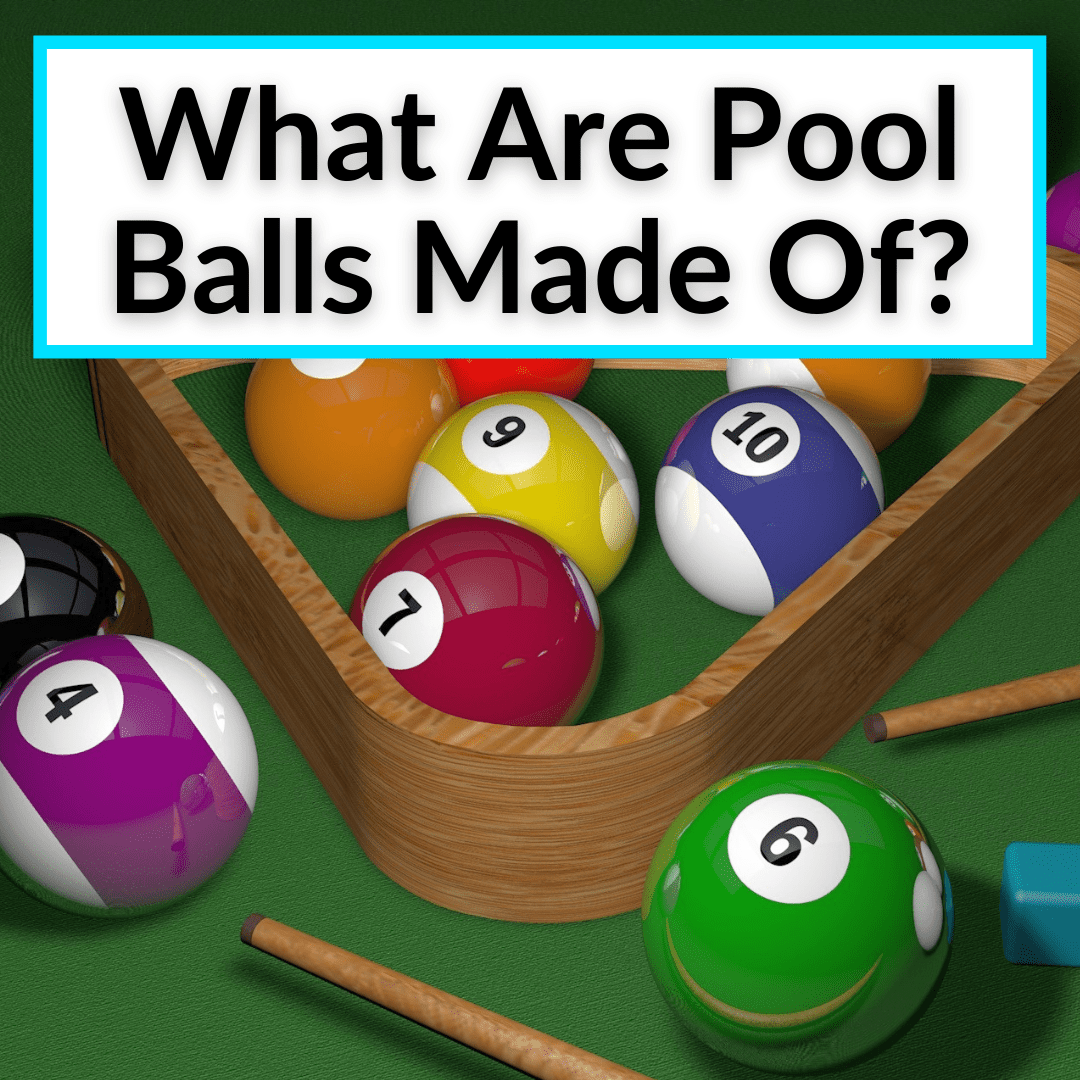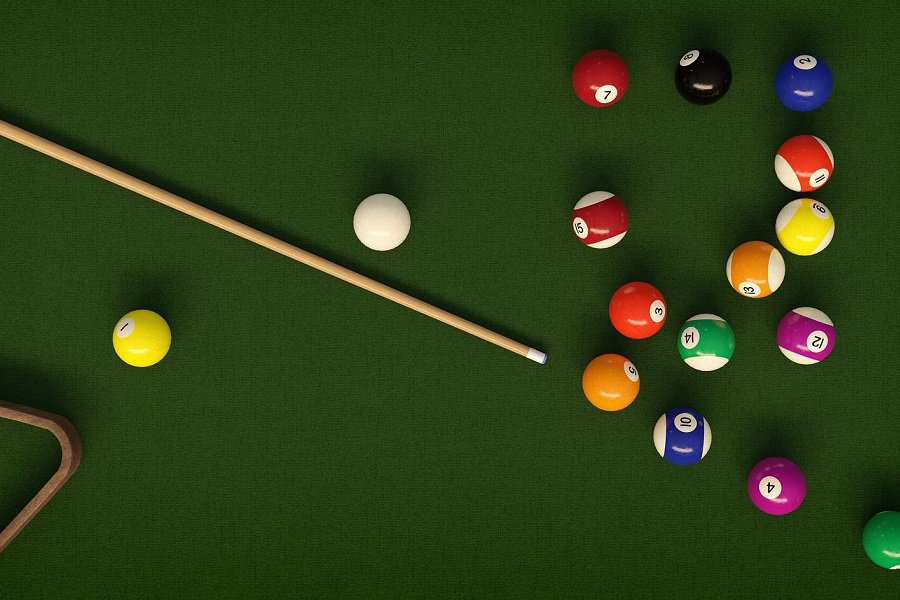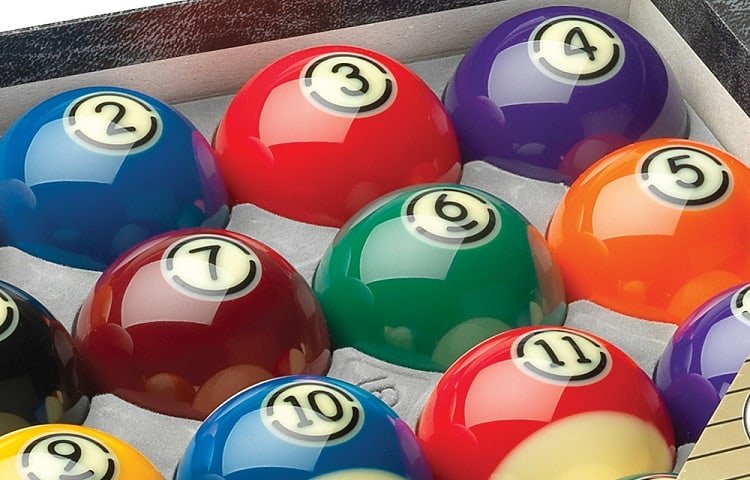 Pool balls have a rough life.
Pool balls have a rough life.
I mean, think about everything they go through.
One gets hit constantly by a pointy stick that sends it careening into various other balls. Those other balls are constantly getting rammed by their colleagues.
No pool ball is safe from the abuse.
And yet, they continue on through it all. What are pool balls made of that allows them to withstand all this abuse?
Keep reading to find out. We’ll dive deep into the modern pool ball, but also take you back in time for a little history lesson. Early billiard balls were nowhere near as tough as those of today.
Table of Contents
What Are Pool Balls Made Of?
Modern pool balls are made of either polyester or phenolic resin. Polyester is cheaper, but not as durable. Phenolic resin lasts much longer, but costs quite a bit more.
We’ll go into a lot more details on each of these materials below.
But before getting into the nitty-gritty details of how a ball is made and what it is made from, it’s useful first get an understanding of the history of the pool ball and how it has evolved over the years.
History Of Pool Balls

Pool and other related sports have been around since the 16th century. But the ball itself evolved during the 19th century. It was originally made of wood or ivory.
No one is sure exactly when the game first appeared, but looking at French historical documents on lawn gaming, we can see a similar game, a mixture of croquet and billiards, played during the 13th century.
During the 17th century, the game evolved drastically to an indoor type game played on a table using cue sticks.
Initially, the pool ball was made from wood, because it was inexpensive and readily available. Of course, people back then lacked the kind of technology we enjoy today.
At the beginning of the 17th century, many European countries began colonizing African countries. In the process, they discovered that ivory from elephants worked better for making high-quality pool balls than wood.
Ivory balls became popular among the rich during this time. But billiard balls made from ivory were prone to yellowing with time, since cracks would appear if excessive force were applied. This was a major drawback for the lovers of the sport.
Not only did they suffer from cracks and yellowing, but the elephant population in Africa was suffering a drastic reduction, in part due to the game’s growing popularity.
Poachers took advantage of the lucrative, but illegal, business of killing elephants for their tusks, which were then exported overseas to various European countries, in order to manufacture pool balls, asa well as other ornaments such as necklaces.
As a result, in 1869, pool table manufacturers Phelan and Collender, challenged their customers with a reward of $10,000 for anyone who could come up with a ball that was not made from ivory.

John Wesly Hyatt took Phelan and Collenderon up on their challenge and combined nitrocellulose, alcohol, and camphor to mold a spherical ball under very high pressure.
Unfortunately, his creations did not win the $10,000 prize offered by the company, but it is now considered among the pioneering moments of synthetic plastics.
He refined his inventions but failed to meet the standard ivory had set. The main problem was that his creations could burst when struck with excessive force. Not an ideal trait in a pool ball.
It wasn’t until the 19th century that an American chemist named Phelan Leo Baekeland came up with a plastic-like substance called Bakelite.
The substance was durable and replaced ivory and wood in making high quality and durable pool balls. This happened around the 1920s.
Modern Pool Balls

Today’s pool balls are made of either polyester or phenolic resin. Cheaper balls like those used on super small pool tables are usually made from much cheaper materials than even polyester.
Balls made from polyester are inexpensive, but prone to faster wear and tear. Balls made from phenolic resin are much more durable and robust, but they also cost a lot more than their counterparts.
Phenolic resin is a mixture of a potent blend of phenol and formaldehyde. This compound is scratch and chip-resistant, outshining most, if not all, of the competition.
Saluc is responsible for more than 85% of all the pool balls being produced worldwide as of today, and they are arguably the best at making these phenolic resin pool balls.
Their technology is simply the best option out there. It lasts and does not tear easily.
How Pool Balls Are Made
As mentioned, most resistant pool balls of today are made from phenolic resin. Manufacturers simply melt the materials, and once stable, the resulting product can not be dissolved again.
This process becomes apparent if you cut right through the center of a pool ball. You’ll notice that the color runs through to the middle of the ball.
The mixture of phenol and formaldehyde gets molded under high pressures, creating a potent substance resistant to strong forces and high temperatures.
That is why the ball does not deform when subjected to different temperature conditions or when hit using very high forces from the cue sticks.
Once the manufacturing process is complete, the balls are then tested under unfavorable conditions to see whether they can withstand these pressures. Each step is double-checked for impurities, before the balls are released to the public.
Aramith makes sure that the chemical bond between the materials in each ball is strong enough to avoid breakage, a problem sometimes seen in standard pool balls made from synthetic materials that are not as strong as phenolic resin.
The other thing to note is that phenolic resin balls look shinier and more vibrant, which may not seem important, but it does make them look more luxurious and adds to the gaming experience.
The reasons why more and more people are picking balls made of phenolic resin for all pool ball colors and numbers include:
- They can withstand high pressure
- They are burn-spot resistant.
- They are scratch and chip resistant
- They last five times longer than polyester-made pool balls
- They are vibrant looking
Did you know that it takes Saluc 23 days to make these balls? That’s mind-boggling!
When you get a phenolic resin ball made by Saluc or Aramith, you know that you are getting the best!
What Pool Balls Are Made Of: Conclusion
Wrapping things up, pool balls made of polyester are cheaper than pool balls made of phenolic resin, but they will not last as long and will likely need to be replaced more often.
While phenolic resin balls are quite expensive, they are the best option for the long term and they require little to no maintenance.
Now that we’ve taken you back in time to the beginnings, and from there through to today’s technology, I hope you now understand in detail what pool balls are made of and why they are made from this particular material. All in all, happy gaming!
Leave a Reply